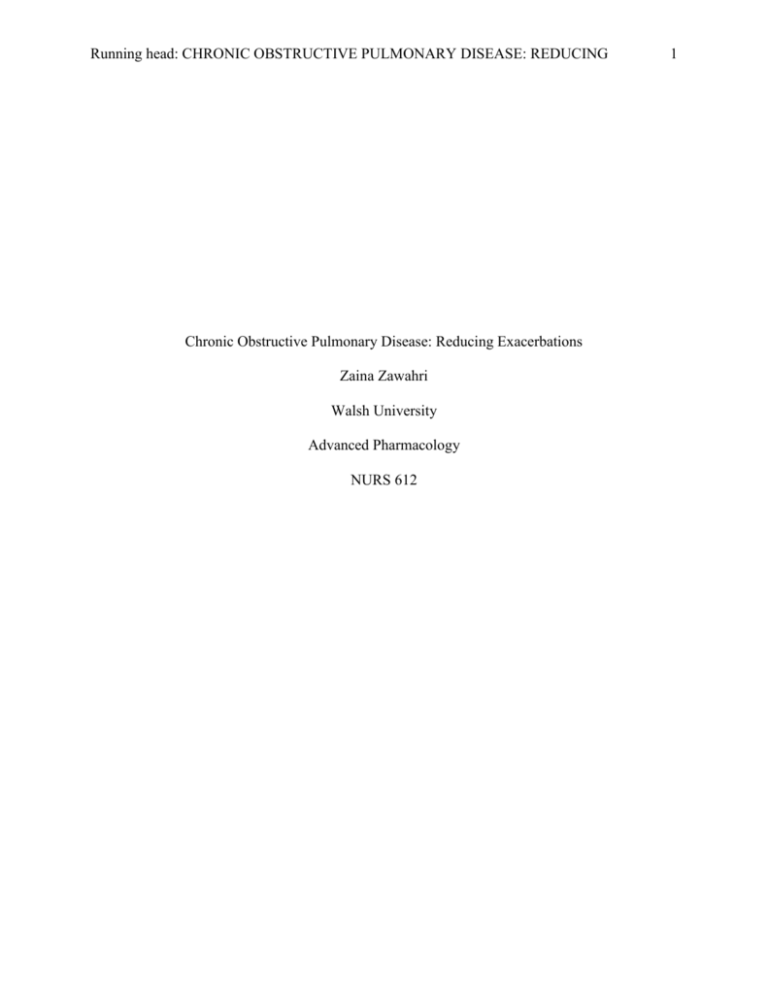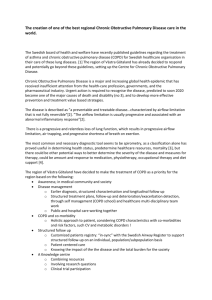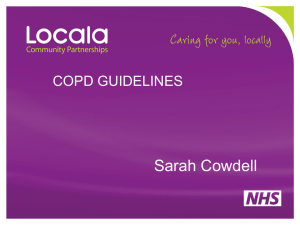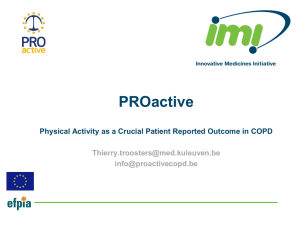
Running head: CHRONIC OBSTRUCTIVE PULMONARY DISEASE: REDUCING
Chronic Obstructive Pulmonary Disease: Reducing Exacerbations
Zaina Zawahri
Walsh University
Advanced Pharmacology
NURS 612
1
CHRONIC OBSTRUCTIVE PULMONARY DISEASE: REDUCING
2
Abstract
Many patients suffer from respiratory illnesses. These illnesses (asthma, chronic obstructive
pulmonary disease [COPD], emphysema, bronchitis) have their highs and their lows, periods of
normalcy and periods of exacerbations. Several treatment plans are available during the
exacerbation periods but what is available during the periods of normalcy to prevent
exacerbations? How can a patient decrease the severity of the exacerbations? This case study
focuses on recurrent COPD exacerbations and the ways to avoid them including early detection
and intervention, nonpharmacological management, and proper use of medications, with a focus
on steroid and antibiotic use. Steroids and antibiotics are often the first medications given during
exacerbation periods, however the complications from long-term misuse and over-use often
outweigh the benefits.
CHRONIC OBSTRUCTIVE PULMONARY DISEASE: REDUCING
3
Chronic Obstructive Pulmonary Disease: Reducing Exacerbations
Those who suffer from COPD understand that exacerbations are a part of the disease
process. As the disease progresses, the exacerbations become more severe and more frequent.
These exacerbations interfere with activities of daily living and overall quality of life. Many
patients complain about the frequent hospital visits and complications from long-term antibiotics
and steroids used to battle the disease process. Research suggests that, if used in a different way,
these medications can be more effective at preventing the frequency and severity of the
exacerbations. In addition, nonpharmacological treatment options can improve lung function,
muscle strength, and overall quality of life.
Chief Complaint, Medical History, & Physical Findings
A 55-year-old Caucasian female presents to the emergency department (ED) with
difficulty breathing, increased swelling in all four extremities, and chest discomfort. She was
discharged from the hospital three weeks prior with a diagnosis of COPD exacerbation. In
addition to COPD, she has a history of headaches, weakness, frequent bronchitis, chronic cough,
emphysema, pneumonia, shortness of breath with rest and exertion, back pain, osteoporosis,
anxiety, depression, panic attacks, heart palpitations, Graves Disease, recurrent urinary tract
infections, hyperthyroidism, and home oxygen therapy. She suffers from fractured vertebrae as a
result of long-term steroid use and complains of fragile skin.
During the initial assessment, the patient is sitting in a tripod position, on three liters
ofoxygen via nasal cannula. Her breathing is shallow and slow, as though she were trying to
calm herself and not waste energy. After placing the patient on the cardiac monitor, vital signs
were obtained and all fell within normal limits. A pulse ox of 94% on the oxygen is slightly low
for the patient; however her portable oxygen tank she was low. The head to toe assessment
CHRONIC OBSTRUCTIVE PULMONARY DISEASE: REDUCING
4
focused on cardiovascular and respiratory. Her lung sounds revealed inspiratory and expiratory
wheezing in the upper lung lobes and diminished breath sounds in the lower lung bases. Her
electrocardiogram displayed normal sinus rhythm and pulses were palpable in all extremities.
She has trace swelling in all four extremities. Although she denied chest pain, she states, “I feel
like there is fluid on my lungs causing this discomfort and pressure.”
Her treatment plan for this ED visit include the electrocardiogram, chest x-ray, blood
work (including blood cultures, complete blood count, complete metabolic panel, cardiac
markers, and the heart failure maker BNP) and IV access. After receiving an initial Duoneb 3ml
nebulizer, she was placed on a Proventil Continuous 23mg treatment for one hour.
Methylprednisolone sodium succinate (Solu-Medrol) 125mg was given IV push. Her lab tests
were normal and her chest x-ray did not show any signs of infection. After the medical
interventions, her symptoms persisted. Her fractured back caused her extreme pain and worsened
her breathing. She was given Vicodin 5-500mg for back pain and started on Levofloxican 500mg
IV piggy back as prophylactic treatment for the exacerbation. The admitting physician came to
assess her and she was admitted with a diagnosis of COPD exacerbation.
Allergies & Medication Profile
Allergies: Morphine and Tape
Acetaminophen (Tylenol) 500mg: 2 tabs PO q4h PRN pain
Acetaminophen-HYDROcodone (Vicodin) 325-10mg: 1 tab PO q4h PRN pain
Albuterol (ProAir HFA MDI) 90mcg/inh: 2puffs Inhalation QID PRN wheezing
Albuterol-ipratropium inhalation aerosol solution (Atrovent) 3ml: Inhalation QID
ALPRAZolam (Xanax) 0.25mg: 1 tab PO QID PRN anxiety
Cyanocobalamin (Vitamin B-12) 100mcg: 1 tab PO Daily
Cyanocobalamin (Vitamin B-12) 1000mcg/ml: IM qMonth
Diltiazem (Cardizem) 180mg/24hr Capsule: 1 capsule PO BID
CHRONIC OBSTRUCTIVE PULMONARY DISEASE: REDUCING
5
Fluticasone-salmeterol (Advair Diskus) 500mcg-50mcg: 1 puff BID
Furosemide (Lasix) 40mg: 1 tab PO BID
Gabapentin (Neurontin) 300mg: 1 capsule PO TID
Methimazole (Tapazole) 5mg: 1 tab PO Daily
Multivitamin: 1 tab PO Daily
Potassium Chloride (K-Dur) oral extended release tablets 10mEq: 1 tab PO TID
Prednisone 20mg: 1 tab PO Daily
Teriparatide (Forteo) 600mcg/2.4ml: 20mcg subq Daily
Tiotropium (Spiriva) 18mcg Inhalation: 1 capsule inhalation daily
Zolpidem (Ambien) 5mg: 2 tablets (total 10mg) PO qHS PRN sleep
Pathophysiology of COPD
COPD is a complex disorder that often begins with a history of cigarette smoking or
exposure to pollutants. The patient in this case study had smoked for over 40 years and quit after
her diagnosis. Smoking and other pollutants activate an inflammatory response in the body. The
inhaled particles cause destruction and an increase in neutrophils and macrophages. There is also
an increase in the release of elastase and protease. This causes damage and breakdown of the
alveolar wall, elastic tissue, and collagen. The result is an increase in mucus secretion, impaired
airway clearance, and the potential collapse of bronchioles that leads to air trapping (Copstead &
Banasik, 2010, p. 551). These physiologic changes explain the symptoms that the patient
displays.
COPD is often made up of several different respiratory illnesses. Commonly, a patient
will suffer from chronic bronchitis and emphysema; both make up the diagnosis of COPD
(Morton & Fontaine, 2009, p. 643). These irreversible disease processes often go undiagnosed
until patients suffer extreme symptoms. In 2010, COPD was the sixth most common cause of
death worldwide and it is projected to become the third by 2020 (Bastin et al., 2010, p. 91). With
CHRONIC OBSTRUCTIVE PULMONARY DISEASE: REDUCING
6
the prevalence of the disease increasing, it is expected that more and more patients will suffer
from exacerbations. COPD exacerbations caused by a viral or bacterial infection or anything that
worsens the inflammatory process. Symptoms of the exacerbation include a worsening of cough,
difficulty breathing, and a change in sputum production causing the patient to have a decreased
quality of life. These periods may also be a sign that the medication needs changed or adjusted
(Wedzicha & Seemungal, 2007, p. 786). It is during this process that steroids and antibiotics are
prescribed, bronchodilators are used more frequently, and oxygen therapies are adjusted
(Wedzicha & Seemungal, 2007). It is this time that patients suffer great consequences and
complications from the misuse and over use of these medications.
Medication Profile Analysis
Looking at the patient’s medication profile, it would appear that her COPD,
complications from the disease process, and medication regimen are worsening. Almost all of the
medications can be related back to COPD, the complications from the COPD, and the use of
long-term steroids and antibiotics. As a result of these complications the patient is placed on
more medication then necessary had her disease been diagnosed earlier.
Pain control is important because it relates to all body functions, heart and respiratory
rate in particular. When a person suffers pain, their heart rate and respiratory rate will increase,
they will use more energy, and become fatigued more easily. As a result of her fractured
vertebrae, the patient is on two pain medications Tylenol and Vicodin. Due to the severity of her
pain, the patient states she takes the Vicodin several times a day. With the use of this medication,
it is imperative that the patient’s respiratory status be monitored, as this medication can suppress
the cough reflex, cause respiratory depression, and impair cognitive ability (Wilson, Shannon,
Shields, & Stang, 2008, p. 743). In addition, her liver enzymes will need to be monitored, as she
CHRONIC OBSTRUCTIVE PULMONARY DISEASE: REDUCING
7
has the potential to develop hepatotoxicity with the use of acetaminophen (Wilson et al., 2008, p.
10). If her pain can be controlled, then her respiratory status can be stabilized.
Her vertebrae fractures are the source of her pain, but where did they come from and why
will they not heal? Research suggests that there is a relationship between COPD and osteoporosis
due to the local and systemic inflammation. There is an increase in serum TNF- α levels that
stimulate the differentiation of macrophages into osteoclasts, although the exact relationship is
unclear (Fabbri, Luppi, Beghe, & Rabe, 2008, p. 207). To prevent any further bone deterioration,
her physicians have placed her on Forteo subcutaneous injections daily. This medication
stimulates new bone formation and increases bone mass and strength. It will be important to
monitor her serum calcium levels and evaluate her injection techniques (Wilson et al., 2008, p.
1466). Although her physicians are treating the osteoporosis, they are forgetting to address
another major cause, long-term steroid use.
The patient has been taking prednisone off and on for years. While in the hospital, she
often receives IV steroids called Solu-Medrol. As with this visit to the ED, the physicians
prescribed her the medication to decrease the inflammation and bronchial spasms (Wilson et al.,
2008, p. 980). The problem occurs when this medication and prednisone are given together.
Prednisone and other glucocorticoids have been associated with an increased risk of developing
osteoporosis. About 30-50% of patients taking this medication will suffer from a fracture and
that number significantly increases as the dose and length of administration increases (Mazziotti,
Canalis, & Giustina, 2010, p. 878). The patient is on a very high dose of daily prednisone. She
states that she has been on this dose since her last hospital admission. Resistance to medications
is likely, however more and more research is proving that it is ineffective in delaying the
progression of the disease. Therefore, long-term use of steroids should be avoided during periods
CHRONIC OBSTRUCTIVE PULMONARY DISEASE: REDUCING
8
of normalcy (Barnes, 2013, p. 638). During exacerbations however, these oral corticosteroids
have been proven to decrease inflammation, improve airflow, and decrease length of hospital
stay (Schweiger & Zdanowicz, 2010, p. 1061). For this particular patient, the fine balance of
steroid use has been upset. She is now forced to take high doses of the medication for much
longer then recommended. During her well periods it will be important to wean her off of the
steroids as quickly and safely as possible to avoid resistance and adverse effects.
Prednisone is a common treatment for many different medical problems. It is best to be
given short term, over the course of a few weeks, slowly increasing and decreasing the dose.
This particular patient has been on high doses of prednisone for a very long time, which can lead
to a decrease in cortisol production by the adrenal glands (Chang-Miller, 2011). Many
complications occur when the body fails to produce cortisol and the synthetic version (in this
case prednisone) is abruptly stopped. The constant suppression of the adrenal glands and
hormone production can lead to damage and insufficiency and abruptly stopping prednisone will
cause damage to the rest of the body (Aulakh & Singh, 2008, p. 1070). Not only will the
symptoms of the disease process occur more rapidly, the patient can suffer from nausea,
vomiting, weakness, fatigue, joint and muscle pain, headache, fever, and lethargy (Katzung,
Masters, & Trevor, 2012, p. 707). The best way to prevent these adverse effects is to slowly
decrease the synthetic steroid. This will allow the adrenal glands to begin producing hormones
again. For this particular patient, research suggests a decrease of prednisone over a three-week
period; with dosing adjustments taking place every three to four days by no more then 25%
(Aulakh & Singh, 2008, p. 1071). The patient will be monitored closely during this process and
will be educated on the signs and symptoms of withdrawal and toxicity. Follow-up evaluation
CHRONIC OBSTRUCTIVE PULMONARY DISEASE: REDUCING
9
after the discontinuation of prednisone, including hormone levels and her osteoporosis related
pain will also be important.
This patient is on several different bronchodilators. Even in severe COPD, patients on
several different bronchodilators have shown significant improvement in their lung function
(Tashkin et al., 2008, p. 746). There are two categories of bronchodilators, short acting beta
agonists (SABA) and long acting beta agonists (LABA). SABA, like albuterol, acts to decrease
airway resistance, which improves mucus secretion and improves lung function. Too much of
this medication can cause significant tremors and increased heart rate (Wilson et al., 2008, p. 3031). Atrovent, another SABA, is a nebulized form of albuterol that prevents bronchospasms in
addition to being a bronchodilator (Wilson et al., 2008, p. 814). These two medications provide
the patient with quick relief, but the LABA are what allow the patient to have improved quality
of life.
The patient is on two LABA, Spiriva and Advair Diskus. Although these medications
provide bronchodilation for a long period of time, there are many risk factors and considerations
that need addressed prior to administration. Hepatic and renal dysfunction can significantly
impair the absorption, distribution, and excretion of the drugs (Allen, Davis, Hardes, Tombs, &
Kempsford, 2012, p. 2317). Patients should be instructed to rinse their mouth thoroughly to
decrease dryness and prevent mouth sores (Wilson et al., 2008, p. 1508). In addition to being a
LABA, Advair Diskus is also an inhaled corticosteroid, which acts directly on the lungs to
decrease inflammation. However, this medication has been associated with an increased risk for
developing pneumonia if used incorrectly (Singh, Amin, & Loke, 2009). Proper use of these
medications will improve quality of life and decrease the frequency of exacerbations.
CHRONIC OBSTRUCTIVE PULMONARY DISEASE: REDUCING
10
With any respiratory condition, infections are common. Antibiotics are often prescribed
to decrease infection severity and fight the bacteria that have invaded the lungs. However,
antibiotics are often prescribed for viral infections and prophylactic treatment. As stated earlier,
the patient had no signs of infection but was given a dose of levofloxacin. Antibiotic use for
acute exacerbations of COPD are very common, but more and more research is showing that
long-term antibiotic use, even during periods of normalcy, may actually decrease the amount and
severity of exacerbations a patient has during the course of a year (Wenzel, Fowler, & Edmond,
2012). Azithromycin is the antibiotic researchers recommend for this treatment plan. It is taken
for three days every 21 days during the winter months. These patients showed an improved
quality of life and reduced exacerbation frequency and severity (Babu, Kastelik, & Morjaria,
2013, p. 802 & 806). When taking antibiotic for long periods and for no reason, one often
wonders about resistance and adverse effects. Careful monitoring will need to take place to
prevent ototoxicity, cardiac toxicity, and drug-drug interactions. Liver enzymes will also need to
be checked, especially in patients with moderate liver disease. This treatment plan will need to
be evaluated frequently, weighing both the pros and cons (Wenzel et al., 2012, p. 343). If this
patient had been started on a long-term antibiotic therapy at the time of her last exacerbation, this
exacerbation might have been prevented.
COPD not only affects the lungs, the heart, and the bones; it also impacts the patient’s
mental health. Many patients who have COPD also have anxiety and depression, with these
disorders increasing as the severity of the disease increases (Clini & Ambrosino, 2008, p. 223).
The patient is taking Xanax up to four times a day and Ambien for sleep as needed. She states
that during her periods of exacerbation, she takes both more often than during her periods of
normalcy. The inability to breathe normally would cause someone to have anxiety and the
CHRONIC OBSTRUCTIVE PULMONARY DISEASE: REDUCING
11
inability to lay flat would cause an inability to sleep. The combination would lead to decreased
energy available to breathe, leading to an increased work of breathing, and the cycle would
continue.
As suggested above, the adjustments to her medications will provide her with an
improved quality of life and less frequent exacerbations. This will allow her to live a fuller, more
enjoyable life without suffering the side effects of the medications. The side effects could have
been avoided, however, if her primary care providers and pulmonologist had utilized
nonpharmacological options and prevention methods sooner in her treatment plan.
Clinical Management Plan: Exacerbation Prevention
COPD exacerbations are inevitable; they are a part of the disease process. The question
still remains: How can these exacerbations be less frequent and less severe? There are both
pharmacological and nonpharmacological ways in which patients can take control of the disease
process and have more periods of normalcy.
The frequency of this patient’s COPD exacerbations is concerning. Although she was
very strict in her medication routine, she still developed another exacerbation. Some alternative
or additions to her therapy would be a long-term antibiotic as mentioned previously, adjustments
to her home oxygen therapy, nutritional consultations, and pulmonary rehabilitation. Most
importantly, patient education and self-management of the disease process need to be addressed.
The patient is on three liters oxygen via nasal cannula constantly. She does not make
adjustments to her oxygen flow based on activity level and her portable oxygen tanks are small,
not providing enough oxygen when she is using the most energy. Proper oxygen therapy use
helps to reduce mortality, anxiety, and depression in many patients (Wedzicha & Seemungal,
2007, p. 793). However, when oxygen therapy is used inappropriately it will cause the opposite.
CHRONIC OBSTRUCTIVE PULMONARY DISEASE: REDUCING
12
It also important to include in her prescription for adjusted flow rates at rest and at activity (Clini
& Ambrosino, 2008, p. 220). For this patient, her oxygen therapy needs to be reevaluated,
possibly new equipment, and a new prescription with adjusted flow rates. This would
significantly improve her quality of life, anxiety, and provide her with more freedom to do the
things that she loves.
Nutrition plays a large role in health and illness. In patients with COPD, like this one,
more energy is required for the simple task of breathing. The patient weighs 57.5 kilograms (126
pounds) and she is approximately 162 centimeters (5feet 3 inches) tall. In COPD, patients suffer
from muscle wasting and depletion due to lack of intake; the work of eating is worse then the
work of breathing (Clini & Ambrosino, 2008, p. 222). This patient is already on a multivitamin
and Vitamin B-12 to help replace what she is unable to consume. A dietitian should be consulted
to instruct the patient on eating smaller, more frequent meals that are high in protein. This will
prevent the full feeling after eating a large meal, which can sometimes cause difficulty breathing,
in addition to allowing for her muscles to rebuild slowly (Clini & Ambrosino, 2008, p. 222).
Once her nutritional status has been evaluated and her oxygen therapy established, she can move
on to pulmonary rehabilitation
Pulmonary rehabilitation is an exercise program for the lungs. It can be done during
periods of normalcy as well as immediately following an exacerbation. The goals of this therapy
are to prevent exacerbations, decrease the severity of exacerbations, restore lung function, and
provide the patient with skills needed to complete activities of daily living (Decramer et al.,
2008, p. S7). This therapy, combined with the improved nutritional status, and adjusted
medications will allow the person to live a more active lifestyle, free from exacerbations.
CHRONIC OBSTRUCTIVE PULMONARY DISEASE: REDUCING
13
These nonpharmacological interventions are designed to give the patient more control
over the disease process. With these changes, educations needs to take place to make patient’s
more aware of slight changes in their breathing, sputum production, or exercise tolerance that
could be early signs of an exacerbation. The earlier an exacerbation is detected, the earlier
treatment can begin, and the less damage will be done to already fragile lung tissue. Early
smoking cessation prior to diagnosis or early in the disease process will improve long-term lung
function and decrease the frequency of exacerbations. Also, immunizations against influenza and
pneumonia have also shown to decrease the rates of exacerbations (Decramer et al., 2008, p. S6).
This patient had utilized all of these pharmacologic and nonpharmacologic methods of
exacerbation prevention; she would have an improved quality of life, and decreased severity of
illness.
Conclusion
COPD affects millions of people around the world. Early detection, intervention, and
prevention of exacerbations are the keys to successful disease management These new
approaches will allow for a decrease in improper antibiotic and steroid use, therefore limiting the
adverse effects and resistance that is an issue for many patients. Proper pain management and
anxiety control can also decrease the energy and work of breathing, again improving the quality
of life. Utilizing a patient’s desire for independence as a strength, COPD exacerbations can be
prevented if healthcare providers take the time to listen.
CHRONIC OBSTRUCTIVE PULMONARY DISEASE: REDUCING
14
References
Allen, A., Davis, A., Hardes, K., Tombs, L., & Kempsford, R. (2012, December). Influence of
renal and hepatic impairment on the pharmacokinetic and pharmacodynamic properties
and tolerability of fluticasone furoate and vilanterol in combination. Clinical
Therapeutics , 34(12), 2316-2332.
Aulakh, R., & Singh, S. (2008, October). Strategies for minimizing corticosteroid toxicity: A
review. Indian Journal of Pediatrics, 75(10), 1067-1073.
Babu, K. S., Kastelik, J., & Morjaria, J. B. (2013, March). Role of long term antibiotics in
chronic respiratory diseases. Respiratory Medicine , 107, 800-815.
Barnes, P. J. (2013, March). Corticosteroid resistance in patients with asthma and chronic
obstructive pulmonary disease. Journal of Allergy and Clinical Immunology, 131(3), 636645.
Bastin, A. J., Starling, L., Ahmed, R., Dinham, A., Hill, N., Stern, M., & Restrick, L. J. (2010).
High prevalence of undiagnosed and severe chronic obstructive pulmonary disease at first
hospital admission with acute exacerbation. Chronic Respiratory Disease, 7(2), 91-97.
Chang-Miller, A. (2011, August 4). Prednisone withdrawal: Why do I need to taper down the
dosage [Discussion group comment]. Retrieved from
http://www.mayoclinic.com/health/prednisone-withdrawal/AN01624
Clini, E. M., & Ambrosino, N. (2008). Nonpharmacological treatment and relief of symptoms in
COPD. European Respiratory Journal , 32(1), 218-228.
Copstead, L. C., & Banasik, J. L. (2010). Pathophysiology (4th ed.). St. Louis, MO: Saunders
Elsevier.
CHRONIC OBSTRUCTIVE PULMONARY DISEASE: REDUCING
15
Decramer, M., Nici, L., Nardini, S., Reardon, J., Rochester, C. L., Sanguinetti, C. M., &
Troosters, T. (2008). Targeting the COPD exacerbation. Journal of Respiratory Medicine
, 102(Supplement 1), S3-S15.
Fabbri, L. M., Luppi, F., Beghe, B., & Rabe, K. F. (2008). Complex chronic comorbidities of
COPD. European Respiratory Journal, 31(1), 204-212.
Katzung, B. G., Masters, S. B., & Trevor, A. J. (2012). Basic & clinical pharmacology (12th
ed.). New York, NY: McGraw Hill Medical .
Mazziotti, G., Canalis, E., & Giustina, A. (2010, October). Drug-induced osteporosis:
Mechanisms and clinical implications. The American Journal of Medicine, 123(10), 877884.
Morton, P. G., & Fontaine, D. K. (2009). Critical care nursing: a holistic approach (9th ed.).
Philadelphia, PA: Wolters Kluwer Health Lippincott Williams & Wilkins.
Schweiger, T. A., & Zdanowicz, M. (2010, July 1). Systemic corticosteroids in the treatment of
acute exacerbations of chronic obstructive pulmonary disease. American Journal of
Health-System Pharmacy, 67, 1061-1069.
Singh, S., Amin, A. V., & Loke, Y. K. (2009, February 9). Long-term use of inhaled
corticosteroids and the risk of pneumonia in chronic obstructive pulmonary disease: A
meta-analysis. Archives of Internal Medicine , 169(3), 219-229.
Tashkin, D. P., Celli, B., Decramer, M., Liu, D., Burkhart, D., Cassino, C., & Kesten, S. (2008).
Bronchodilator responsiveness in patients with COPD. European Respiratory Journal,
31(4), 742-750.
Wedzicha, J. A., & Seemungal, T. A. (2007, September 1). COPD exacerbations: Defining their
cause and prevention. The Lancet, 370, 786-796.
CHRONIC OBSTRUCTIVE PULMONARY DISEASE: REDUCING
16
Wenzel, R. P., Fowler, A. A., & Edmond, M. B. (2012, July 26). Antibiotic prevention of acute
exacerbations of COPD. The New England Journal of Medicine, 367(4), 340-347.
Wilson, B. A., Shannon, M. T., Shields, K. M., & Stang, C. L. (2008). Prentice hall: Nurse’s
drug guide. Upper Saddle River, NJ: Pearson/Prentice Hall.










